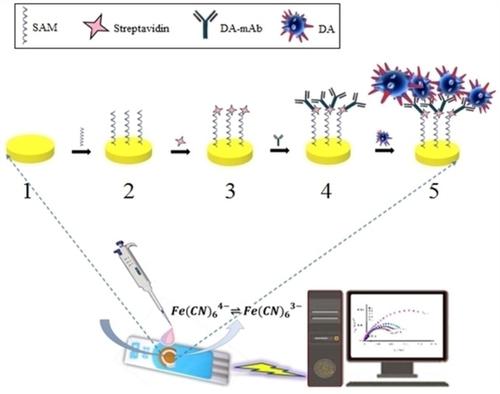当前位置:
X-MOL 学术
›
Electroanalysis
›
论文详情
Our official English website, www.x-mol.net, welcomes your
feedback! (Note: you will need to create a separate account there.)
Electrochemical Investigation of Gold Based Screen Printed Electrodes: An Application for a Seafood Toxin Detection
Electroanalysis ( IF 2.7 ) Pub Date : 2020-11-27 , DOI: 10.1002/elan.202060433 Yücel Koç 1, 2 , Uğur Moralı 1 , Salim Erol 3 , Huseyin Avci 2, 4, 5
Electroanalysis ( IF 2.7 ) Pub Date : 2020-11-27 , DOI: 10.1002/elan.202060433 Yücel Koç 1, 2 , Uğur Moralı 1 , Salim Erol 3 , Huseyin Avci 2, 4, 5
Affiliation

|
Although commercial screen‐printed electrodes (SPEs) are used extensively for biosensor purposes nowadays, detailed studies on characterization are still limited. In this study, the surface of the gold‐based screen‐printed electrode (SPGE) was carefully modified with self‐assembly‐monolayer through an optimized immobilization procedure. The key physical and chemical properties with regeneration capacity of the developed biosensors were assessed by various characterization techniques. Then SPGE was used to determine its sensitivity, limit of detection (LOD) and limit of quantification (LOQ) for a toxin substance of domoic acid in seafood that has become more common and rising concern of marine wildlife and seawater pollution. LOD in phosphate buffered saline (PBS) and cell culture media were obtained as 2.93 ng mL−1 and 4.28 ng mL−1, respectively. The reduced sensitivity for antibody‐based biosensors in the cell culture medium was probably due to interaction of nonspecific compounds with DA in the culture medium compared to the much less complex environment of PBS. In addition, the regeneration capacity has been found very limited due to inherent heterogeneity and low robustness. This study can be used for the main challenges with the design requirements of commercial SPE‐based biosensors to provide a detailed perspective for further toxicity studies.
中文翻译:

金基丝网印刷电极的电化学研究:在海鲜毒素检测中的应用
尽管如今商业丝网印刷电极(SPE)广泛用于生物传感器,但有关表征的详细研究仍然有限。在这项研究中,通过优化的固定程序,以自组装单层仔细修饰了金基丝网印刷电极(SPGE)的表面。通过各种表征技术评估了已开发生物传感器的关键物理和化学性质以及再生能力。然后,SPGE用于确定其灵敏度,检测限(LOD)和定量限(LOQ),用于检测海鲜中海藻酸的毒素物质,该物质已变得越来越普遍,并且引起了海洋野生动植物和海水污染的关注。磷酸盐缓冲盐水(PBS)和细胞培养基中的LOD为2.93 ng mL -1和分别为4.28 ng mL -1。细胞培养基中基于抗体的生物传感器的灵敏度降低可能是由于非特异性化合物与培养基中DA的相互作用所致,与PBS复杂得多的环境相比。另外,由于固有的异质性和低的鲁棒性,已经发现再生能力非常有限。这项研究可用于解决基于商用SPE的生物传感器的设计要求面临的主要挑战,从而为进一步的毒性研究提供详细的前景。
更新日期:2020-11-27
中文翻译:

金基丝网印刷电极的电化学研究:在海鲜毒素检测中的应用
尽管如今商业丝网印刷电极(SPE)广泛用于生物传感器,但有关表征的详细研究仍然有限。在这项研究中,通过优化的固定程序,以自组装单层仔细修饰了金基丝网印刷电极(SPGE)的表面。通过各种表征技术评估了已开发生物传感器的关键物理和化学性质以及再生能力。然后,SPGE用于确定其灵敏度,检测限(LOD)和定量限(LOQ),用于检测海鲜中海藻酸的毒素物质,该物质已变得越来越普遍,并且引起了海洋野生动植物和海水污染的关注。磷酸盐缓冲盐水(PBS)和细胞培养基中的LOD为2.93 ng mL -1和分别为4.28 ng mL -1。细胞培养基中基于抗体的生物传感器的灵敏度降低可能是由于非特异性化合物与培养基中DA的相互作用所致,与PBS复杂得多的环境相比。另外,由于固有的异质性和低的鲁棒性,已经发现再生能力非常有限。这项研究可用于解决基于商用SPE的生物传感器的设计要求面临的主要挑战,从而为进一步的毒性研究提供详细的前景。











































 京公网安备 11010802027423号
京公网安备 11010802027423号